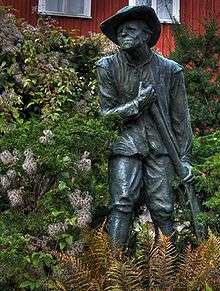Snapphane
A snapphane was a member of a 17th-century pro-Danish guerrilla organization that fought against the Swedes in the Second Northern and Scanian Wars, primarily in the former eastern Danish provinces which in the course of these wars became southern Sweden. Many pro-Danish guerrilla fighters referred to themselves as friskyttar, ei volunteer militiamen.
The term snapphane, which was used as a pejorative term by the Swedes to describe the pro-Danish rebels, was originally a word for gangs of bandits that lived in the woods. When Scanian exiled peasants were organized by the Danish king into bands that fought the Swedes with guerrilla methods, they were called Snapphane too.

Due to the movement's support of the Danish invasion during the Scanian War, Swedish authorities fought the snapphanes brutally, and if one was captured, he was usually executed and the corpse was impaled and shown where the locals could see it and be intimidated to obedience. Another common method was execution by having them broken on the wheel. The Snapphanes were initially rather successful, but as the war turned against Denmark the Snapphane war became more devastating. The Snapphanes were defeated mostly by a Swedish campaign of compelling Scanian peasants swear allegiance to the Swedish king, effectively driving a wedge between Snapphane and most of the population. Instructed by the Danish king to kill loyalists the Snapphane bands turned on the local population undermining support for the Danish king. A ruthless Swedification policy was reportedly so effective that when a Danish invasion army landed in 1709, in the wake of the Battle of Poltava, the local population was raised in a militia to fight against them. The last suspected snapphane, Nils Tuasen‚ was executed in 1700 for slaying a Swedish soldier in 1677. He had allegedly spent 22 years in exile in Denmark but ultimately returned, upon which he was arrested and put to death.[1]

Snapphanes made an impact on Swedish popular culture. In modern times, the Swedish Navy patrol boat P161 is named HMS Snapphanen. It is part of a class of vessels several of which are named after paramilitary professions, like Kaparen (privateer), Spejaren (scout), etc.
Literature
- Kim Hazelius, De Kallades Snapphanar.. Bokpro Bjärnum 2006 (ISBN 91-89336-40-2).
- K Arne Blom, Jan Moen, Snapphaneboken.
- Palle Lauring (1952). Danmark i Skåne. Stockholm: Berghs förlag, 1999 (ISBN 91-502-1368-7).
- Herman Lindquist (1995). Historien om Sverige – storhet och fall. Norstedts Förlag, 2006 (ISBN 91-1-301535-4).
- Mats Olsson (2001). "Att icke understå sig att lämna sina hemman: Om bondeklassens frihet och adelns dominans i Skåne". Historisk Tidskrift, 2001 (1): 5–28. ISSN 0345-469X.
- Sixten Svensson (2005). Sanningen om snapphanelögnen. (ISBN 91-975695-1-8).
- Sten Skansjö (1997). Skånes historia. Lund (ISBN 91-88930-95-5).
- Alf Åberg, (1951).Snapphanarna.Stockholm: LTs Förlag.
- Alf Åberg (1994). Kampen om Skåne under försvenskningstiden. Stockholm: Natur och Kultur (912704355X).
- Alf Åberg (1975). I snapphanebygd. Stockholm: Rabén & Sjögren.
- Cederborg, Carl August (1913). Kopparskrinet.
- Cederborg, Carl August (1987). Mickel Göing.
- Cederborg, Carl August (1912). Göingehövdingen I.
- Cederborg, Carl August (1912). Göingehövdingen II.
In popular culture
A historical miniseries entitled Snapphanar was made for Swedish television in 2006. A film featuring Edvard Persson from 1941 bears the same name.
See also
References
- ↑ "GC19ED4 Snapphanar - Bäckabro (Traditional Cache) in Skåne, Sweden created by Lady & Lufsen i samarbete med Hässleholms Turism". Geocaching.com. Retrieved 2012-10-01.